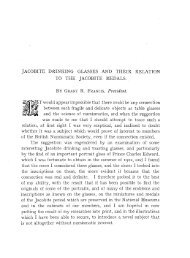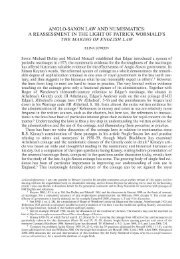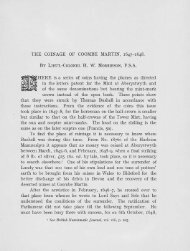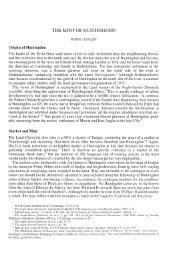Early Northumbrian Coins at Auction, 1981 - British Numismatic ...
Early Northumbrian Coins at Auction, 1981 - British Numismatic ...
Early Northumbrian Coins at Auction, 1981 - British Numismatic ...
Create successful ePaper yourself
Turn your PDF publications into a flip-book with our unique Google optimized e-Paper software.
EARLY NORTHUMBRIAN COINS AT AUCTION, <strong>1981</strong> 47<br />
Non alium nummum argenteum praeter peningum sive denarium a<br />
Saxonibus fuifse excusum haud assero; sed mirari interim subit,<br />
nullum alium antiquariis nostris aliquando occurrifse, si quis<br />
alius olim extiterit. Fountain P:l64 -<br />
The penny was perhaps the only silver coin <strong>at</strong> least no other has<br />
yet been discovered; the halfling is by several Authors reported<br />
to have been a real silver coin. Strutts Chronicles P:234.<br />
V:..lld:-<br />
<strong>Coins</strong> of the Anglo-Saxon Kings are almost universally silver & of<br />
the antient Penny size & weight - a number of insignificant<br />
pieces of copper likewise occur; they are worth about half a farthing<br />
and were coined only in Northumberland towards the termin<strong>at</strong>ion<br />
- Efsay on Medals P.147 -<br />
The Heptarchic coins are mostly rare, save the sticas, which are<br />
very common: P.230 & 266.<br />
60. The coin was wrapped in a small bit of paper; recto:<br />
Wigmund. (archepiscopus Eboracensis) (Anno 835) Egberht (sole<br />
monarch of the Ang:Sax) /E.Stica. verso: Vigmund Arc: Rev: /No<br />
stica's being found but wh<strong>at</strong> were apparently coined in the Kingdom<br />
of Northumberland it may be concluded none were coind elsewhere.<br />
The stica was worth about 1/22 of a Saxon penny, - &<br />
equall to about 1/2 of a Farthing of our money - Strutts Chronicles<br />
Vol:II. P:235 - /Wimundus, eleventh archbishop died about<br />
the 854 (sic) - vide Drakes Eboracum P409 - weight 15i Gr:<br />
These (for 59 and 60), by their handwriting and by the references<br />
quoted, can almost certainly be ascribed to the l<strong>at</strong>e 18th century<br />
(John Pinkerton's Essay on Medals was published in 1784). It is<br />
a gre<strong>at</strong> pity th<strong>at</strong> the coins' provenances are not recorded.<br />
11 ii There was no document<strong>at</strong>ion for this group other than a modern<br />
note to the effect th<strong>at</strong> the sce<strong>at</strong> and the three stycas had originally<br />
been together in a piece of coloured paper.<br />
Iliii There was no document<strong>at</strong>ion other than a small wrapping paper<br />
labelled: "Stycas 2".<br />
Iliv There was no document<strong>at</strong>ion for this group; the outer wrapping<br />
was labelled "Stycas"; the individual packet for 72 was labelled<br />
in a hand different from th<strong>at</strong> which labelled the others.<br />
IIv With these coins was a piece of printed paper forming part of a<br />
publisher's prospectus for France in the Reign of Louis Phillipe,<br />
by Thomas Allom and G.N.Wright, which was published in 1845.<br />
One wonders if the coins themselves might be another handful<br />
from the York, 1842, hoard.<br />
Another piece of printed paper, boldly labelled 'Stycas' in manuscript, must<br />
have been the outer wrapping for all the coins acquired before the parcels<br />
from York 1842 and Bolton Percy 1847. The text is th<strong>at</strong> of a parliamentary<br />
deb<strong>at</strong>e on the Established Church: the d<strong>at</strong>e is given only as 8 July. Although<br />
the page form<strong>at</strong> is not th<strong>at</strong> of Hansard, a check of Hansard identifies<br />
the deb<strong>at</strong>e as having taken place on 8 July 1836.



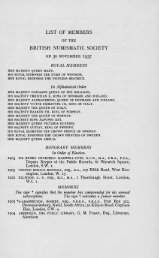

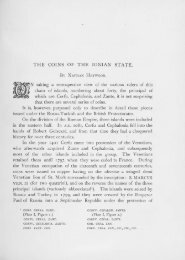
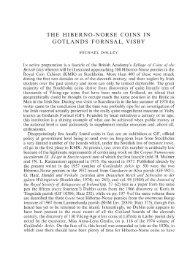
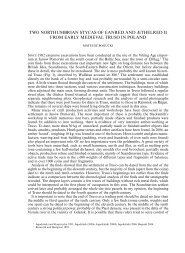
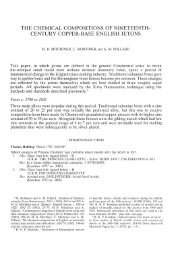
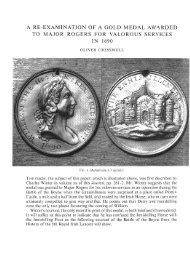
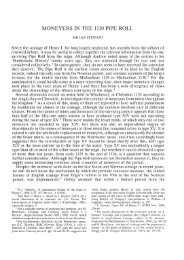
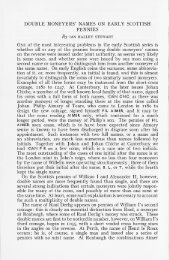
![Two Anglo-Saxon notes: [1] A Cnut die-link between the mints of ...](https://img.yumpu.com/15433998/1/189x260/two-anglo-saxon-notes-1-a-cnut-die-link-between-the-mints-of-.jpg?quality=85)
